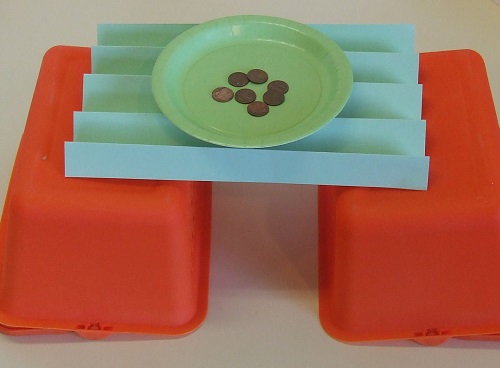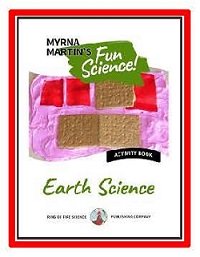Which Bridge Will Hold tHe Most weight?
Building Sturdy Bridges
These physical science activities are easy and fun to do. You will be creating three different bridges out of paper. The goal is to see how much weight each bridge can hold without collapsing and dumping its load into the river below the bridge.

Materials
- Sheet of plain paper
- Bridge supports (plastic buckets, books, etc.)
- Paper plate or cup
- Pennies or washers
Directions
- Create two bridge supports that are the same height.
- You can use
books, plastic buckets or blocks of wood.
- The first bridge you will
build is very simple. Simple lay a piece of paper between the two bridge
supports.
- Test to see how much weight the bridge will hold by placing a
paper plate on the bridge and adding pennies, one at a time, to the
paper plate.
- If the bridge supports are close together slowly pull them
apart testing the carrying load of your bridge.
- This was the first type of bridges built by people. People would simply put a log across a stream that was too swift to cross on foot.
- The second bridge you will build is an arch bridge. Bring the two
bridge supports so they are 6 inches apart.
- Place your paper between the two bridge supports so it forms an arch. Test the carrying capacity of this bridge. This bridge design was first used by the Greeks during the Bronze Age.
- Fold your paper like a fan or accordion.
- Place your "fan" bridge
on top of the bridge supports. Test the carrying load of the bridge the
same way you did the previous two bridges.
- Compare the carrying capacity of the three bridges.

Our Earth Science activity contains 42 pages of fun activity that kids will love to do. Activities in the book include Inside a Volcano, Normal & Reverse Faults, and Globe Toss. Myrna Martin

Click for More Information and to Order
Science behind the activity
In these physical science activities you can see that bridges which spread out the force or weight are stronger than bridges that do not.
- The first bridge's weight was directed at the edge of the two bridge supports.
- The arch bridge weight is supported by the abutments at either side of the arch.
- The "fan" bridge's weight is shared with many support structures making it very strong. The larger and fewer number of folds of the fan the more weight it can support.
More Links to Fun Science Activities
Water Cycle Activity, Heavy Water Watch what happens when ice cubes floating in a container begin to melt!
Star Activity, The Big Dipper and Southern Cross Create the two constellations that have guided sailors at night for thousands of years in this inexpensive and fun activity.
Volcano Activities, Modeling Magma In this yummy activity you will create a magma chamber using Jell-O and fruit!
Dinosaur Activities, Dinosaur Footpint Cookies These dinosaur activities are fun to make and good to eat!
Physical Science Activities, Building Bridges Construct several paper bridges in this fun activity!
Science Activities Links to activities on this page include building bridges, creating spouting water, growing sugar crystals and much more.
Kids Fun Science The links on this page include information science activities, science experiments, plate tectonics, the rock cycle and much more.
KIDS FUN Science Bookstore
Check out Myrna Martin's award winning textbooks, e-books, videos and rock sets. The Kids Fun Science Bookstore covers a wide range of earth science topics. Click here to browse.










